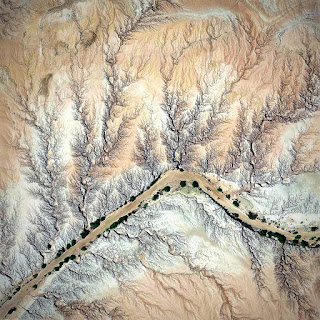From a closer view, Yuri Gagarin, first person in space, described earth looking from his space capsule as - “What beauty. I saw clouds and their light shadows on the distant dear earth…. The water looked like darkish, slightly gleaming spots…. When I watched the horizon, I saw the abrupt, contrasting transition from the earth's light-colored surface to the absolutely black sky. I enjoyed the rich color spectrum of the earth. It is surrounded by a light blue aureole that gradually darkens, becoming turquoise, dark blue, violet, and finally coal black.”
And even closer, but far from its surface, earth reveals countless features carved by nature or built by man. The book is a collection of images, found on Google Earth, showing a mere fraction of earths unusual sites from the beauty of a Yemen desert, to a strange land formation in Mongolia, or the exquisite design of the city of Dubai to the haunting aerial view of Auschwitz. These images show earth’s vast diversity from above ranging from 500 to several thousand feet.
Google Earth provides the tool for this exploration. One can spend innumerable hours searching earth’s 57 million square miles for exceptional compositions made by nature and man. Put into scale, San Francisco is 49 square miles offering numerous aerial views and is only 1/1,170,000 of earth’s landmass. On a standard monitor, at 1000’ above ground, Google Earth displays approximately 2.6 percent of one square mile. At that height, it would take 45 million displays to cover earth’s land.
If MacLeish and Gagarin were alive today they would marvel over Google Earth and its capability to show earth’s beauty and man’s impact and would question our stewardship of our small blue fragile sphere.
(Click on image to enlarge and show thumbnails or scroll down.)

















